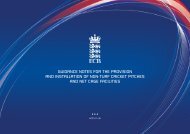speak for most of us. I have learnt so muchfrom my colleagues <strong>and</strong> I am still on thatjourney. <strong>Cricket</strong> has provided me with a lifetimeof enjoyable experiences <strong>and</strong> I hopethat I will be able to continue to inspire,mentor, support <strong>and</strong> celebrate umpires <strong>and</strong>scorers.“I am so very grateful <strong>and</strong> privileged.Thank you.”RUNNERS-UPDeborah BurnsDeborah became aqualified memberof the Associationof <strong>Cricket</strong> Officialsin 1982 <strong>and</strong> sincethen has spentthous<strong>and</strong>s of hourssupporting <strong>and</strong>championing the role of officials withinMiddlesex.She was appointed the Middlesex <strong>ACO</strong>Education Officer in 1992 taking on the responsibilityof arranging, administering <strong>and</strong>recruiting c<strong>and</strong>idates for 100+ courses duringthis period. In addition to this role, shehas personally tutored <strong>and</strong> mentored the c<strong>and</strong>idateson <strong>and</strong> off the field <strong>and</strong> has been thego to person for the <strong>Board</strong>.She is also a keen umpire, umpiring ladiesmatches at every opportunity <strong>and</strong> also assistingthe MCC in this role whenever required.She has been a favourite for many teams <strong>and</strong>is a true inspiration for others to take up umpiring,she has had an incredible influenceon ensuring men’s <strong>and</strong> women’s cricket isofficiated by qualified <strong>ACO</strong> umpires <strong>and</strong> alwaysadvocates the highest possible st<strong>and</strong>ards.Unfortunately Deborah has had to retirefrom her role within the <strong>ACO</strong> this year dueto the ill health of her husb<strong>and</strong>. Despite this,she is still umpiring <strong>and</strong> playing a key rolein mentoring <strong>and</strong> assisting the new committeeto ensure her st<strong>and</strong>ards are maintained inthe future.Alan EnglishAlan has held the post of Education Officerfor the Bucks Association of <strong>Cricket</strong> Officials(formerly BACUS) for the last fifteenyears. Throughout this period, Alan has organisedall the Bucks winter courses for umpires<strong>and</strong> scorers<strong>and</strong> has personallyinstructed atleast one courseevery year.Alan’s preparationis outst<strong>and</strong>ing<strong>and</strong> the highst<strong>and</strong>ard of his tutoringis reflectedin the above averagepassesachieved by Bucks umpires in the ECB examinations.Alan is often the one who volunteersto travel the longest distances to the farend of the County <strong>and</strong> this is typical of hisdedication to the role.During the summer season Alan spendsmuch of his time mentoring <strong>and</strong> assessingnewly-qualified umpires. Recently, thiswork has extended to working with youngofficials from other counties at regional <strong>and</strong>national festivals. A large number of currentBucks ump ires <strong>and</strong> scorers who officiate inBucks matches at all levels are products ofB<strong>ACO</strong> courses <strong>and</strong> all owe a debt of gratitudeto Alan <strong>and</strong> his team.Best Practice: An Insight intoLevel 3 UmpiringMatti Watton of Middlesex runs through his technical report titled‘Dealing with Unacceptable Behaviour in the Professional ArenaAt their October meeting, the Ealing & District ACU&S wasgiven the opportunity to observe two Level 3 researchprojects. ECB <strong>ACO</strong> was delighted to hear that Matti Watton<strong>and</strong> Paul Nicholls were keen to share their knowledge withtheir local association. This is a great example of ContinuousProfessional Development in practice that we fully support <strong>and</strong>endorse more of.Matti Watton began by explaining the general principles of the Level3 Course, including the emphasis on personal development <strong>and</strong> learningfrom other sports. The Pilot had comprised 6 modules, completedover 18 months to two years, looking at self, match <strong>and</strong> conflict management,colleague co-operation, difficult decision making <strong>and</strong> limitedovers cricket. Assessment of c<strong>and</strong>idates was based on a technicalreport in essay form <strong>and</strong> a presentation.The first of these technical reports entitled ‘Dealing with Pressure’was presented by Paul Nicholls who asked, “What if it all goeswrong?” “We’ve all been there, you’ve just given one LBW <strong>and</strong> thenext ball ploughs into the striker’s pads, there is an even louder appeal!Technically both balls look the same – can you easily give thesecond one out too? Under pressure do you ‘hold or fold?’ How doyou cope?”Everyone has their own ‘coping style’ Paul declared, with the emphasison style rather than strategy, a too rigid term. He put forwardthe idea of a ‘mental bin’ where any decision right or wrong shouldnot be dwelt upon; “Put it in the bin, forget about it for now, but revisitlater, at an appropriate time”.Looking to other sports Paul had collected evidence of how refereescope with pressure. It is important to cultivate a personal relaxationtechnique with each official building a model that suited him or her.Deep breathing techniques <strong>and</strong> positive body posture are important, asis having an effective concentration technique focused by positiveself-talk.Positive self-talk involves remaining focused <strong>and</strong> calm; if there is aproblem realise it, put it in the bin <strong>and</strong> work on it in the future. Avoidnegative self-talk – ‘What a stupid thing to do’ or ‘I’ve blown mychances now’!In summary Paul emphasised an umpire’s need to exhibit positivemindset <strong>and</strong> body language <strong>and</strong> to develop <strong>and</strong> maintain a consistentstyle.Matti Watton’s technical report was entitled ‘Dealing with UnacceptableBehaviour in the Professional Arena’ <strong>and</strong> was based on a DevelopmentPlan <strong>and</strong> information from other sports. Studying personalitytypes had helped him underst<strong>and</strong> how he might deal with certainsituations <strong>and</strong> to realise how players with different profiles might seethings differently. The need to underst<strong>and</strong> the perspective of professionalplayers was emphasised as well as the importance of not focusingon being popular, but on gaining respect.Matti then looked at the experience of football referees <strong>and</strong> strategiesthey used when controlling players <strong>and</strong> at rugby referees whowere ‘miked up’ during matches. He found that the good referees usedclear communication, effective body language <strong>and</strong> good positioningskills. Use of specific language aimed at inclusivity is important, such‘we’ not ‘I’ e.g. ‘we think’ or ‘we need’ where ‘we’ = ‘the game’ or‘all the people here’ <strong>and</strong> use of ‘be careful’ when not quite sure whathas happened – but you know it is not quite right!Matti concluded by highlighting ‘Preventative Officiating’ i.e. praisingplayers when appropriate <strong>and</strong> working to develop a rapport withplayers, including knowing who will be in a match <strong>and</strong> what issuesmight have arisen in the past so that they may be avoided. However inthe following Q&A he stressed the importance of not being too familiarwith players you know well, especially if you only know one side.Finally, Paul Nicholls’ single most important piece of advice was tokeep physical <strong>and</strong> mental control of yourself at all times, don’t seektrouble but deal with it when needs be.Ealing & District ACU&S, Oct 2012.Editor Note: Level 3 c<strong>and</strong>idates are nominated by their <strong>ACO</strong>. It is theRegional Performance Officers responsibility to collate <strong>and</strong> presentthe case for the nominees to the national Performance Committeewho have the final say. It is hoped that County <strong>ACO</strong>’s <strong>and</strong> Leagueswill put on Level 3 modules locally to maintain ECB <strong>ACO</strong>’s desire tobe inclusive by providing ‘Education of all’.e-mail us at ecbaco@ecb.co.uk 10 contact us on 0121 446 2710
History of the Umpiring SignalSix months ago, we received an email from a curious member. “Do you know how the signalswere developed into those that we use today?”After a search of the internet it became apparent that we were going to struggle to find a suitableanswer, therefore we asked the MCC Laws department who pointed us to Neil Robinson, MCC’sResearch Officer, who has supplied us with the following information. A special vote of thanksgoes to him.How the library of umpire signals was determined appeared to be unknown, until now…it all beganin 1892…1892: The 1892 issue of the Laws in Wisden(1890 code) states: “An umpire has to count theballs delivered, signify to scorers whether any ofthem are wides, byes, leg-byes or no-balls.” Thismakes no mention of the nature of these signals,however. The ‘Instructions to Umpires’ issued bythe MCC Committee as an appendix to the Lawson June 20 th 1892 make no mention of signals atall.1899: The extension of these instructions issuedduring the 1899 season dealt with declarations <strong>and</strong>again made no mention of signaling.1901: The minutes of the MCC Committee meetingheld on January 7 1901 include a call for thedrafting of a code of signaling to be appended tothe Instructions to Umpires.There is no further mention of the code within theminutes, but FS Ashley-Cooper in Feats, Facts<strong>and</strong> Figures of 1901 relates that “During the seasonof 1901 the committee of the M.C.C. alsodrew up a “Code of Signaling” for umpires.”1902: The 1902 issue of the Laws published inWisden included a revised <strong>and</strong> extended list of instructionsto the umpires, which included for thefirst time the “code of signaling”:➔➔➔➔➔➔➔➔➔“Boundaries” shall be signaled by waving theh<strong>and</strong> from side to side“Byes” shall be signalled by raising the openh<strong>and</strong> above the head.“Leg byes” shall be signaled by raising theleg <strong>and</strong> touching it with the h<strong>and</strong>.“Wides” shall be signaled by extending botharms horizontally.“No-balls” shall be signaled by extending onearm horizontally.The decision “out” shall be signaled by raisingthe index finger above the head.Umpires should wait until a signal has beenanswered by the scorer before allowing thegame to proceed.Besides signaling the Umpire should “Call”distinctly for the information of the players.On giving a decision the Umpire should makesure that the batsmen underst<strong>and</strong>s [sic] whatthe decision is.There is no attribution or date attached to thiscode. Both the original instructions to umpires issuedin 1892 <strong>and</strong> all other subsequent amendmentsto these have the exact date they were passed bythe MCC Committee attached to them in Wisden.Part 2: Other sources1886: The Theory <strong>and</strong> Practice of <strong>Cricket</strong> byCharles Box (1868), contains extensivenotes on the Laws <strong>and</strong> their interpretation,but only one mention of signals:“The calling of a “leg-bye” is usuallyperformed by the umpire putting hish<strong>and</strong> to his leg, or lifting the leg up.”This suggests rather an informal practicethan anything else.1870-71: The Australian <strong>Cricket</strong>ers’ Guide 1870-71 contains a section Hints to Umpires,which mentions only the following:“Leg-byes should be called aloud to thescorers, by the umpire at the bowler’swicket, as soon as the run is made. Thebowler’s umpire, also, is the properparty to give notice by byes to the scorers– best done by holding up the h<strong>and</strong>.”No other signals are mentioned in thisshort work. Again, the tone is one of advice,rather than injunction, <strong>and</strong> the implicationis that no formal code existedat this time.1897: <strong>Cricket</strong> by WJ Ford (1897) containsmore description of signals on p.74:“Umpires have a code of signals bywhich they communicate with the scorers.Thus, a bye is signaled by holdingup the h<strong>and</strong>; a leg-bye by touching orlifting the leg; a boundary hit by wavingone arm horizontally; <strong>and</strong> a wide bywaving both. A no-ball <strong>and</strong> a short run,being loudly called, require no signal.The scorer answers <strong>and</strong> acknowledgessignals by holding up his h<strong>and</strong>.”Conclusion:Comparing WJ Ford with the 1902 Code in Wisden,it seems apparent that before 1901 umpires hadevolved an informal code of signals among themselves,which was restricted to byes, leg-byes,boundaries <strong>and</strong> wides. When MCC first codifiedumpiring signals in 1901 it added signals for ‘noball’<strong>and</strong> ‘out’, although whether these were new inventionsor had become part of the informal codesince 1897 is open to speculation. No minutes existfor the <strong>Cricket</strong> sub-committee of this period, but itis possible that correspondence on the issue may berevealed during the further cataloguing of the MCCarchive in 2012-13.Dead Ball signalFour signalOut signalSix signale-mail us at ecbaco@ecb.co.uk 11 contact us on 0121 446 2710



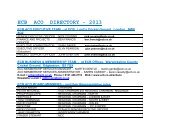
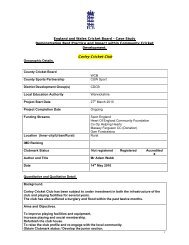
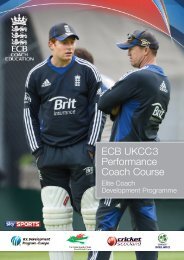

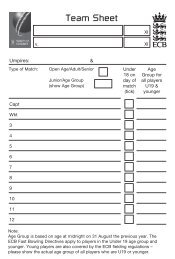
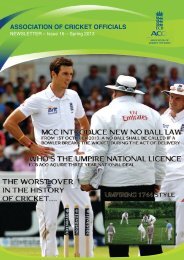
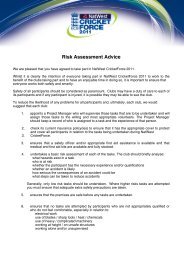
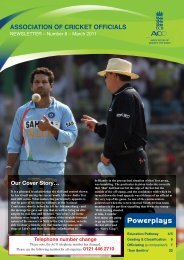


![Indoor Sports Halls with Cricket Provision [TS3] - Ecb - England and ...](https://img.yumpu.com/49070696/1/190x135/indoor-sports-halls-with-cricket-provision-ts3-ecb-england-and-.jpg?quality=85)

